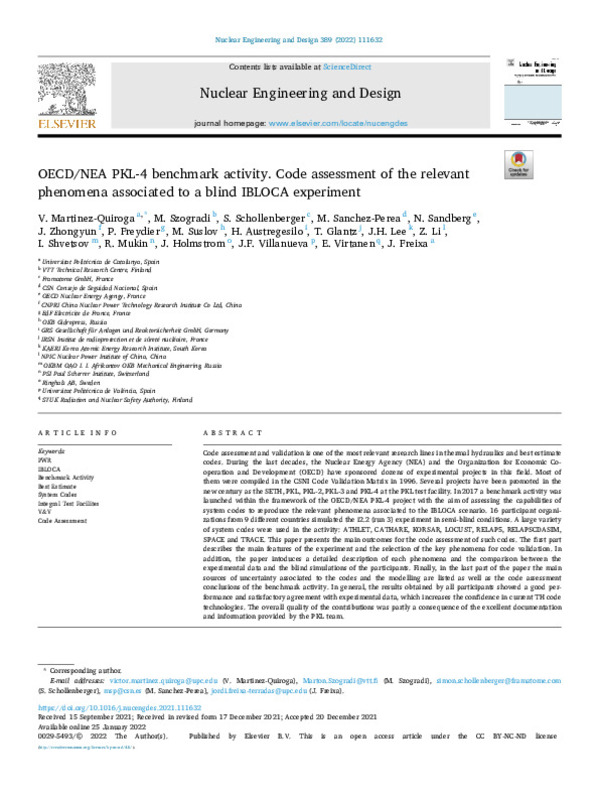JavaScript is disabled for your browser. Some features of this site may not work without it.
Buscar en RiuNet
Listar
Mi cuenta
Estadísticas
Ayuda RiuNet
Admin. UPV
OECD/NEA PKL-4 benchmark activity. Code assessment of the relevant phenomena associated to a blind IBLOCA experiment
Mostrar el registro sencillo del ítem
Ficheros en el ítem
| dc.contributor.author | Martínez-Quiroga, V.
|
es_ES |
| dc.contributor.author | Szogradi, M.
|
es_ES |
| dc.contributor.author | Schollenberger, S.
|
es_ES |
| dc.contributor.author | Sánchez-Perea, M.
|
es_ES |
| dc.contributor.author | Sandberg, N.
|
es_ES |
| dc.contributor.author | Zhongyun, J.
|
es_ES |
| dc.contributor.author | Freydier, P.
|
es_ES |
| dc.contributor.author | Suslov, M.
|
es_ES |
| dc.contributor.author | Austregesilo, H.
|
es_ES |
| dc.contributor.author | Glantz, T.
|
es_ES |
| dc.contributor.author | Lee, J. H.
|
es_ES |
| dc.contributor.author | Li, Z.
|
es_ES |
| dc.contributor.author | Shvetsov, I.
|
es_ES |
| dc.contributor.author | Mukin, R.
|
es_ES |
| dc.contributor.author | Holmstrom, J.
|
es_ES |
| dc.contributor.author | Villanueva López, José Felipe
|
es_ES |
| dc.contributor.author | Virtanen, E.
|
es_ES |
| dc.contributor.author | Freixa, J.
|
es_ES |
| dc.date.accessioned | 2023-09-22T18:02:12Z | |
| dc.date.available | 2023-09-22T18:02:12Z | |
| dc.date.issued | 2022-04-01 | es_ES |
| dc.identifier.issn | 0029-5493 | es_ES |
| dc.identifier.uri | http://hdl.handle.net/10251/196984 | |
| dc.description.abstract | [EN] Code assessment and validation is one of the most relevant research lines in thermal hydraulics and best estimate codes. During the last decades, the Nuclear Energy Agency (NEA) and the Organization for Economic Cooperation and Development (OECD) have sponsored dozens of experimental projects in this field. Most of them were compiled in the CSNI Code Validation Matrix in 1996. Several projects have been promoted in the new century as the SETH, PKL, PKL-2, PKL-3 and PKL-4 at the PKL test facility. In 2017 a benchmark activity was launched within the framework of the OECD/NEA PKL-4 project with the aim of assessing the capabilities of system codes to reproduce the relevant phenomena associated to the IBLOCA scenario. 16 participant organizations from 9 different countries simulated the i2.2 (run 3) experiment in semi-blind conditions. A large variety of system codes were used in the activity: ATHLET, CATHARE, KORSAR, LOCUST, RELAP5, RELAPSCDASIM, SPACE and TRACE. This paper presents the main outcomes for the code assessment of such codes. The first part describes the main features of the experiment and the selection of the key phenomena for code validation. In addition, the paper intoduces a detailed description of each phenomena and the comparison between the experimental data and the blind simulations of the participants. Finally, in the last part of the paper the main sources of uncertainty associated to the codes and the modelling are listed as well as the code assessment conclusions of the benchmark activity. In general, the results obtained by all participants showed a good performance and satisfactory agreement with experimental data, which increases the confidence in current TH code technologies. The overall quality of the contributions was partly a consequence of the excellent documentation and information provided by the PKL team. | es_ES |
| dc.description.sponsorship | The present work contains findings that were produced within the OECD/NEA PKL-4 project. The authors are grateful to the Management Board of the project for their consent to this publication. | es_ES |
| dc.language | Inglés | es_ES |
| dc.publisher | Elsevier | es_ES |
| dc.relation.ispartof | Nuclear Engineering and Design | es_ES |
| dc.rights | Reconocimiento - No comercial - Sin obra derivada (by-nc-nd) | es_ES |
| dc.subject | PWR | es_ES |
| dc.subject | IBLOCA | es_ES |
| dc.subject | Benchmark Activity | es_ES |
| dc.subject | Best Estimate | es_ES |
| dc.subject | System Codes | es_ES |
| dc.subject | Integral Test Facilites | es_ES |
| dc.subject | V&V | es_ES |
| dc.subject | Code Assessment | es_ES |
| dc.subject.classification | INGENIERIA NUCLEAR | es_ES |
| dc.title | OECD/NEA PKL-4 benchmark activity. Code assessment of the relevant phenomena associated to a blind IBLOCA experiment | es_ES |
| dc.type | Artículo | es_ES |
| dc.identifier.doi | 10.1016/j.nucengdes.2021.111632 | es_ES |
| dc.rights.accessRights | Abierto | es_ES |
| dc.contributor.affiliation | Universitat Politècnica de València. Escuela Técnica Superior de Ingenieros Industriales - Escola Tècnica Superior d'Enginyers Industrials | es_ES |
| dc.description.bibliographicCitation | Martínez-Quiroga, V.; Szogradi, M.; Schollenberger, S.; Sánchez-Perea, M.; Sandberg, N.; Zhongyun, J.; Freydier, P.... (2022). OECD/NEA PKL-4 benchmark activity. Code assessment of the relevant phenomena associated to a blind IBLOCA experiment. Nuclear Engineering and Design. 389:1-20. https://doi.org/10.1016/j.nucengdes.2021.111632 | es_ES |
| dc.description.accrualMethod | S | es_ES |
| dc.relation.publisherversion | https://doi.org/10.1016/j.nucengdes.2021.111632 | es_ES |
| dc.description.upvformatpinicio | 1 | es_ES |
| dc.description.upvformatpfin | 20 | es_ES |
| dc.type.version | info:eu-repo/semantics/publishedVersion | es_ES |
| dc.description.volume | 389 | es_ES |
| dc.relation.pasarela | S\476680 | es_ES |
| dc.contributor.funder | CONSEJO DE SEGURIDAD NUCLEAR | es_ES |








